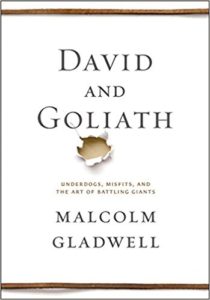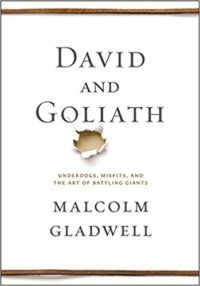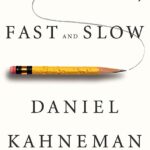 By: Malcolm Gladwell
By: Malcolm Gladwell
Reviewed By: Shelby Brown
The Premise: Malcolm Gladwell presents a series of unusual and unique stories that challenge the image of success. Beginning with the age old story of David & Goliath, Gladwell executes a storyline that emphasizes the resilience of the ‘underdog’ and illustrates a unique way to bounce back from a setback.
David & Goliath: Underdogs, Misfits and the Art of Battling Giants is raw, factual and written in a way that challenges the norms of what the path to success can look like. His prose illustrates how resiliency can allow your weaknesses to become your strengths, as your compensation for this weakness develops into a valuable skill. The book starts with the infamous Bible story “David & Goliath”. He sets the stage with this story showing that resiliency has different forms and to win, sometimes you need to embrace a different strategy if you are up against a ‘giant’. Gladwell demonstrates that if you are the underdog and you want to ‘win’, you need to be resilient in the sense that you do not have to accept the ‘traditional battle field’; you’re used to compensating for your weaknesses, where a ‘giant’ is not.
In the beginning of the book, Gladwell explores “the ways in which we are often misled about the nature of advantages.” As he moves through these unique traits of resilience, he directs “our attention to the other side of the ledger,” and digs deeper into what we conventionally construct disadvantages to be. “What do you mean when we call something a disadvantage? Conventional wisdom holds that a disadvantage is something that ought to be avoided – that it is a setback or a difficulty that leaves you worse off than you would be otherwise.” He surprises us and shows that this may not always hold true and explores the “desirable difficulties” – a concept developed by Robert Bjork and Elizabeth Bjork – which is a “beautiful and haunting way of understanding how underdogs come to excel.” Gladwell uses examples throughout the entire book to describe the theories he suggests. He assigns a chapter to exploring the connection between disadvantages and success; specifically with dyslexia. He highlights stories of resilience and ‘real’ tales of those who developed a lifelong resiliency and created a new strength as a result of continually compensating for a weakness. Those with “desirable difficulties” had the “ability to deal with failure” as it “was very highly developed. [They looked] at most situations and [saw] much more of the upside than the downside. Because [they were] so accustomed to the downside” – the ultimate battle of resiliency.
The Bottom-line: The concepts covered in this book cover the most foundational forms of resiliency. Having resiliency and the ability to bounce back from setbacks are embedded in all of Gladwell’s chapters and are such unconventional stories of resiliency and extremely thought provoking. Gladwell illustrates different levels of setbacks; “desirable difficulties”, trauma, loss and disability, and shows how unconventional resiliency creates a ‘win’. There is more to resilience than the act of persistency, it’s learning how to compensate for your weaknesses and allow your downside to become your upside.
Recommendation: If you are looking for a different perspective on resiliency, a perspective that is real, raw and challenging, then this is a book for you! I recommend giving this a read and utilizing the lessons in this book by channeling them into your everyday/work routines – you may just find you’ve become a little more resilient.




